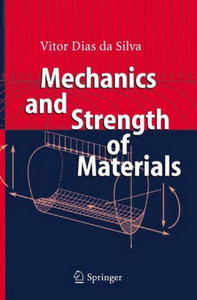

“Mechanics and Strength of Materials” by Vitor Dias da Silva
Sрringеr | 2006 | ISBN: 3540251316 9783540251316 | 532 pages | PDF | 26 MB
This book gives a clear and thorough presentation of the fundamental principles of mechanics and strength of materials; Provides both the theory and applications of mechanics of materials on an intermediate theoretical level. The book is useful as a reference tool by postgraduates and researchers in the fields of solid mechanics as well as practicing engineers.
This treatise contains topics on Solid Mechanics, the Theory of Slender Members and an Introduction to the Theory of Structures, usually taught in the disciplines of Strength of Materials of most Engineering courses, such as Civil, Mechanical and Aeronautical Engineering.
The book is divided in two parts: part 1 treats mechanics of materials based on continuum mechanics principles, and part 2 discusses the fundamental behavior of the strength of materials
Contents
Preface To The English Edition
Preface to the First Portuguese Edition
Part I Introduction to the Mechanics of Materials
I Introduction
1.1 General Considerations
1.2 Fundamental Definitions
1.3 Subdivisions of the Mechanics of Materials
II The Stress Tensor
II.1 Introduction
11.2 General Considerations
11.3 Equilibrium Conditions
11.4 Stresses in an Inclined Facet
11.5 Transposition of the Reference Axes
11.6 Principal Stresses and Principal Directions
11.7 Isotropic and Deviatoric Components of the Stress Tensor
11.8 Octahedral Stresses
11.9 Two-Dimensional Analysis of the Stress Tensor
11.10 Three-Dimensional Mohr’s Circles
11.11 Conclusions
11.12 Examples and Exercises
III The Strain Tensor
III.1 Introduction
111.2 General Considerations
111.3 Components of the Strain Tensor
111.4 Pure Deformation and Rigid Body Motion
111.5 Equations of Compatibility
111.6 Deformation in an Arbitrary Direction
111.7 Volumetric Strain
111.8 Two-Dimensional Analysis of the Strain Tensor
111.9 Conclusions
III. 10 Examples and Exercises
IV Constitutive Law
IV.1 Introduction
IV.2 General Considerations
IV.3 Ideal Rheological Behaviour – Physical Models
IV.4 Generalized Hooke’s Law
IV.5 Newtonian Liquid
IV.6 Deformation Energy
IV.7 Yielding and Rupture Laws
IV.8 Concluding Remarks
IV.9 Examples and Exercises
Part II Strength of Materials
V Fundamental Concepts of Strength of Materials
V.1 Introduction
V.2 Ductile and Brittle Material Behaviour
V.3 Stress and Strain
V.4 Work of Deformation. Resilience and Tenacity
V.5 High-Strength Steel
V.6 Fatigue Failure
V.7 Saint-1Venanfs Principle
V.8 Principle of Superposition
V.9 Structural Reliability and Safely
V.10 Slender Members
VI Axially Loaded Members
VI.1 Introduction
VI.2 Dimensioning of Members Under Axial Loading
VI.3 Axial Deformations
VI.4 Statically Indeterminate Structures
VI.5 An Introduction to the Prestressing Technique
VI.6 Composite Members
VI.7 Non-Prismatic Members
VI.8 Non-Constant Axial Force – Self-Weight
VI.9 Stress Concentrations
VI. 10 Examples and Exercises
VII Bending Moment
VII.1 Introduction
VII.2 General Considerations
VII.3 Pure Plane Bending
VII.4 Pure Inclined Bending
VII.5 Composed Circular Bending
VII.6 Deformation in the Cross-Section Plane
VII.7 Influence of a Non-Constant Shear Force
VII.8 Non-Prismatic Members
VII.9 Bending of Composite Members
VII.10 Nonlinear bending
VII.11 Examples and Exercises
VIII Shear Force
VIII.1 General Considerations
VIII.2 The Longitudinal Shear Force
VIII.3 Shearing Stresses Caused by the Shear Force
VIII.4 The Shear Centre
VIII.5 Non-Prismatic Members
VIII.6 Influence of a Non-Constant Shear Force
VIII.7 Stress State in Slender Members
VIII.8 Examples and Exercises
IX Bending Deflections
IX.1 Deflections Caused by the Bending Moment
IX.2 Deflections Caused by the Shear Force
IX.3 Statically Indeterminate Frames Under Bending
IX.4 Elasto-Plastic Analysis Under Bending
IX.5 Examples and Exercises
X Torsion
X.1 Introduction
X.2 Circular Cross-Sections
X.3 Closed Thin-Walled Cross-Sections
X.4 General Case
X.5 Optimal Shape of Cross-Sections Under Torsion
X.6 Examples and Exercises
XI Structural Stability
XI.1 Introduction
XI.2 Fundamental Concepts
XI.3 Instability in the Axial Compression of a Prismatic Bar
XI.4 Instability Under Composed Bending
XI.5 Examples and Exercises
XI.6 Stability Analysis by the Displacement Method
XII Energy Theorems
XII.1 General Considerations
XII.2 Elastic Potential Energy in Slender Members
XII.3 Theorems for Structures with Linear Elastic Behaviour
XII.4 Theorems of Virtual Displacements and Virtual Forces
XII.5 Considerations About the Total Potential Energy
XII.6 Elementary Analysis of Impact Loads
XII.7 Examples and Exercises
Answers to Proposed Exercises
Index
http://filepost.com/files/486a6ma5/MechanicsStrengthMaterials.pdf/